November 30, 2015 |
BITE: My Journal
Found in Translation: La Chine (CLOSED)
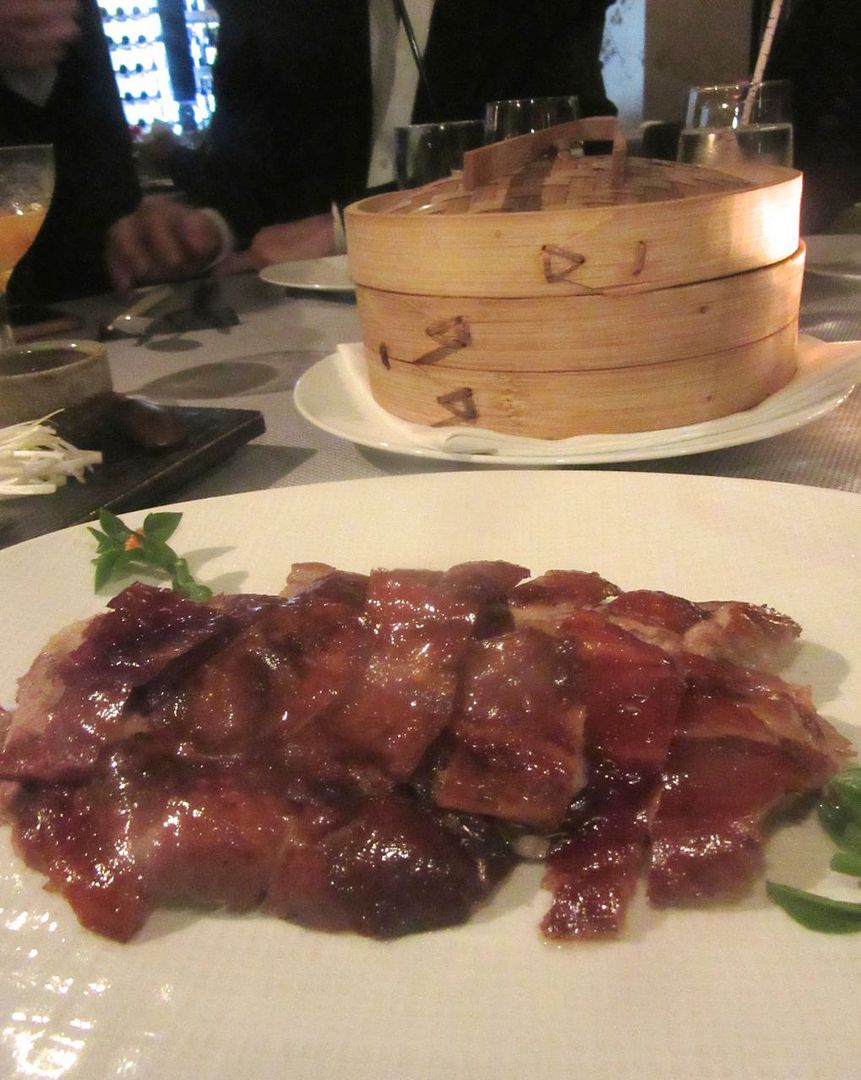
A half portion of duck is two tastes for each of our six. Understated Chinese motifs include hand-painted cherry blossom wallpaper.
As I trudged through the Waldorf Astoria, walking past the elevators and Peacock Alley, covering the entire block from Park Avenue to the exit on Lexington, I was deeply disappointed. I had expected to see little Mao-like creatures here and there, martial arts champions, possibly some scattered chinoiserie on walls and tables, a store selling jade souvenirs…but no. Nothing. Not even a discreet indication that New York’s iconic vintage hotel had been bought by a Chinese company.

The grand chandelier and tall orchids is the only splash in a deliberately staid room.
I rode a small escalator down to the Lexington Avenue level and I saw it on my left: the door to La Chine, the restaurant that has replaced Oscar’s American Brasserie. Now it will get Chinese, I thought. But no. The two women at the greeting stand were not even Asian. One took my coat without giving me a check. Very elegant. The other led me to a table where a small cup held closely bunched, shocking pink calla lilies.

Through a Chinoserie design, a semi-private dining alcove.
Our exceedingly Caucasian waitress had a just-hatched softness. Not like a hotel union waiter at all. She confessed to training for seven weeks. I knew there’d been an opening party. I figured they had been serving for a week or so since, but no…my friends and I (six of us) had rudely arrived on opening night.

Shocking pink calla lilies in a small vase on the table and my Negroni.
We were the only people there. I studied the carefully curated Asian-inflected cocktails but couldn’t find an option that didn’t have one or two ingredients I prefer to live without. I ordered a Negroni. A friend ordered “The Dream,” made with shochu. Each $16.
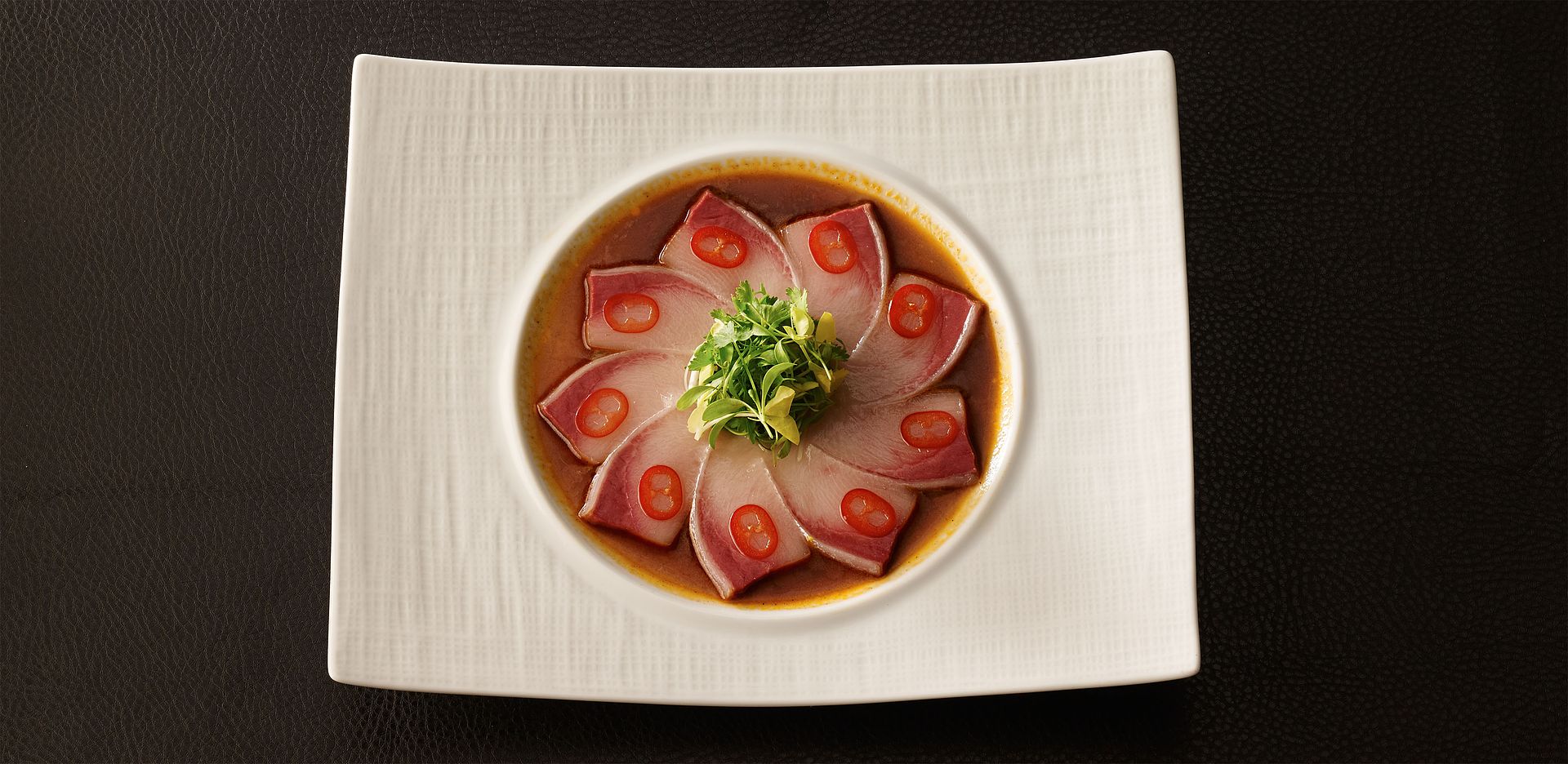
The culinary collaborators are proud of the Chinese raw bar and this yellowtail from the website.
My pals gave me the nod to choose. I noted the five-star hotel prices -- $9 to $29 for starters, $26 to $39 for entrees, $65 for a whole barbequed duck with crepes. My mouth was set for Chinese food. I thought of the golden days of great Chinese master chefs in New York, long gone.
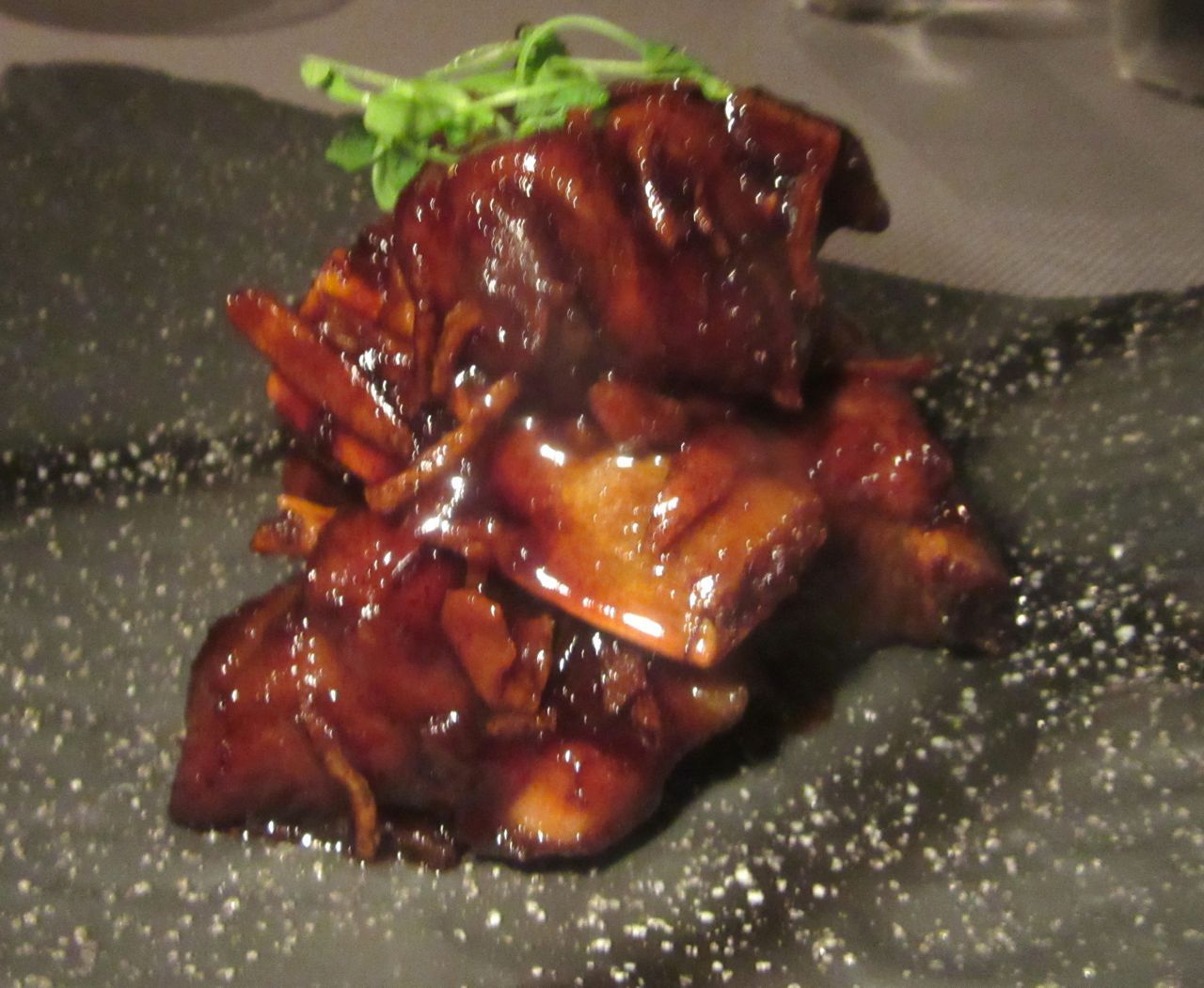
Sweet and satiny, these kumquat pork ribs slide right off the bone – a must among the starters.
I decided to skip raw bar offerings, the crudo you find everywhere now. I ordered bone-in kumquat pork ribs with slivers of sweet pepper. They were dazzlingly sweet -- brilliant, fatty flesh sliding off the bone – shockingly delicious, but only one for each of us. The drinks hadn’t arrived yet.
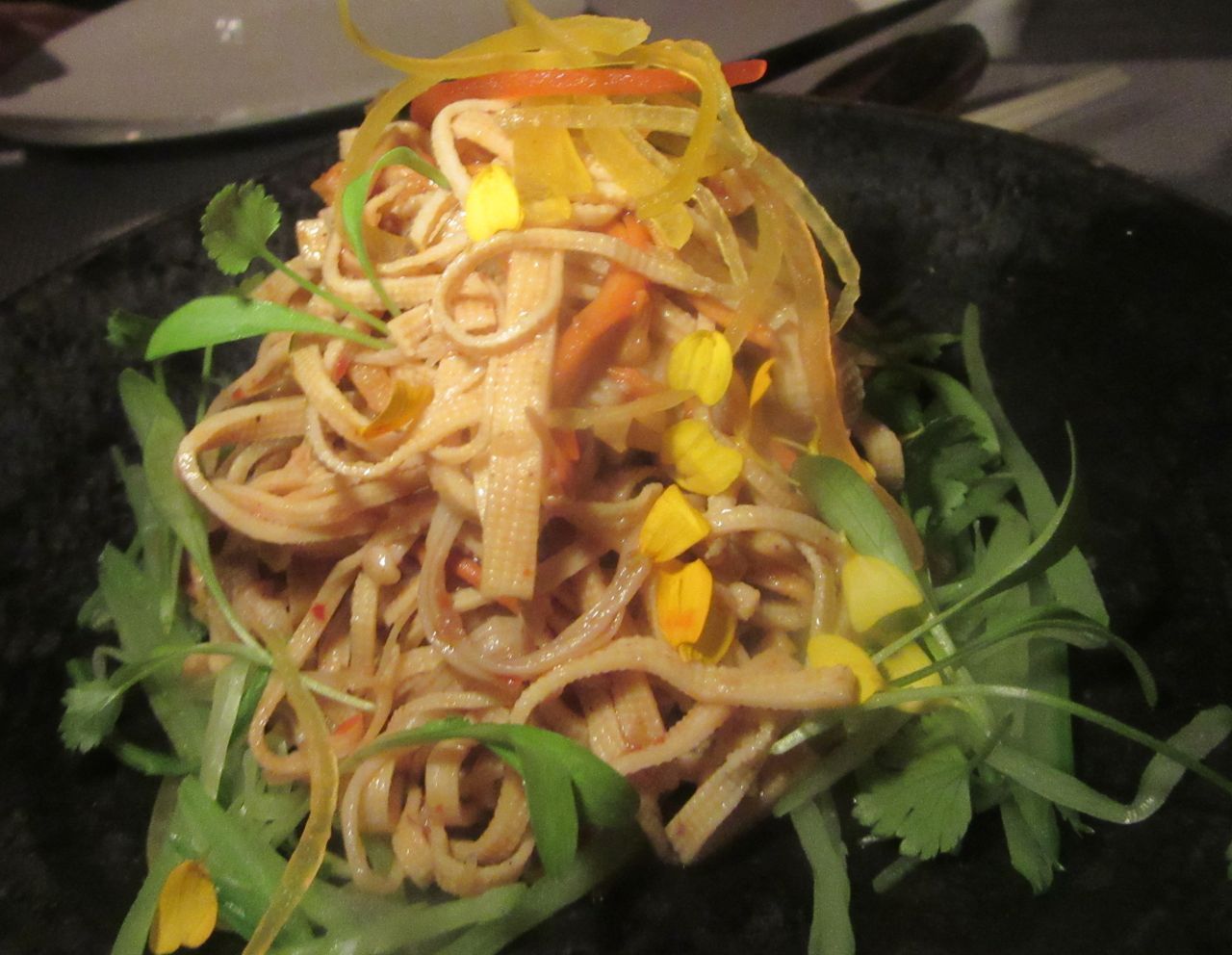
Shredded tofu with enokis and crodyceps (caterpillar fungus available as a health supplement.)
There were votes for an encore of the ribs, just as a modest haystack of shredded tofu salad with enoki mushrooms and something called cordyceps landed. That was delicious too. The kitchen should be grateful to have us to practice on, I thought.

Not long beans for long, these are chopped to bits, tossed with minced pork and pickled lettuce.
I ordered half a Peking duck, so we’d have appetite to taste more dishes. That’s what it was. Half a portion of exceptionally juicy duck with sweet, crisp shards of skin, and delicate little crepes to wrap it in. Besides the usual hoisin, scallion, and cucumber, there were thin strips of melon. The kitchen had yet to master timing. Dinner was staggering with long timeouts. Our non-drinker was on his fifth club soda.
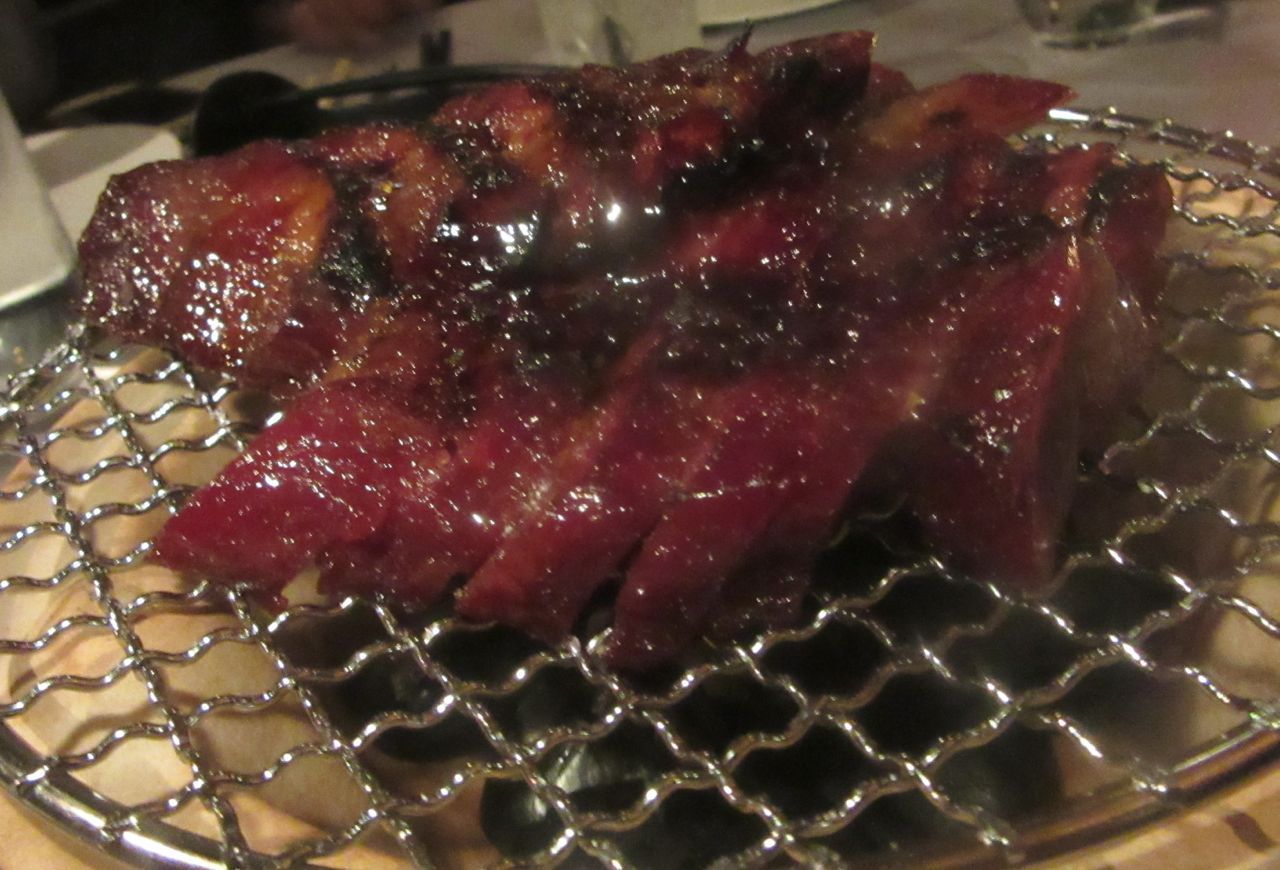
The kitchen uses liquid nitrogen to fuse honey from Waldorf’s rooftop bees onto pork collar.
Mostly, the food was good or pretty good when it wasn’t surprisingly good. Well, maybe the Berkshire pork collar was too sweet for some of my pals. It had been brûléed in honey from the hotel’s rooftop apiaries, we were told. Brûléed with liquid nitrogen, I later learned.) But we murmured over the sautéed pea shoots and wok-fired long beans chopped into the size of small peas and tossed with minced pork and pickled lettuce. And the less pleasing beef short ribs were barely touched.
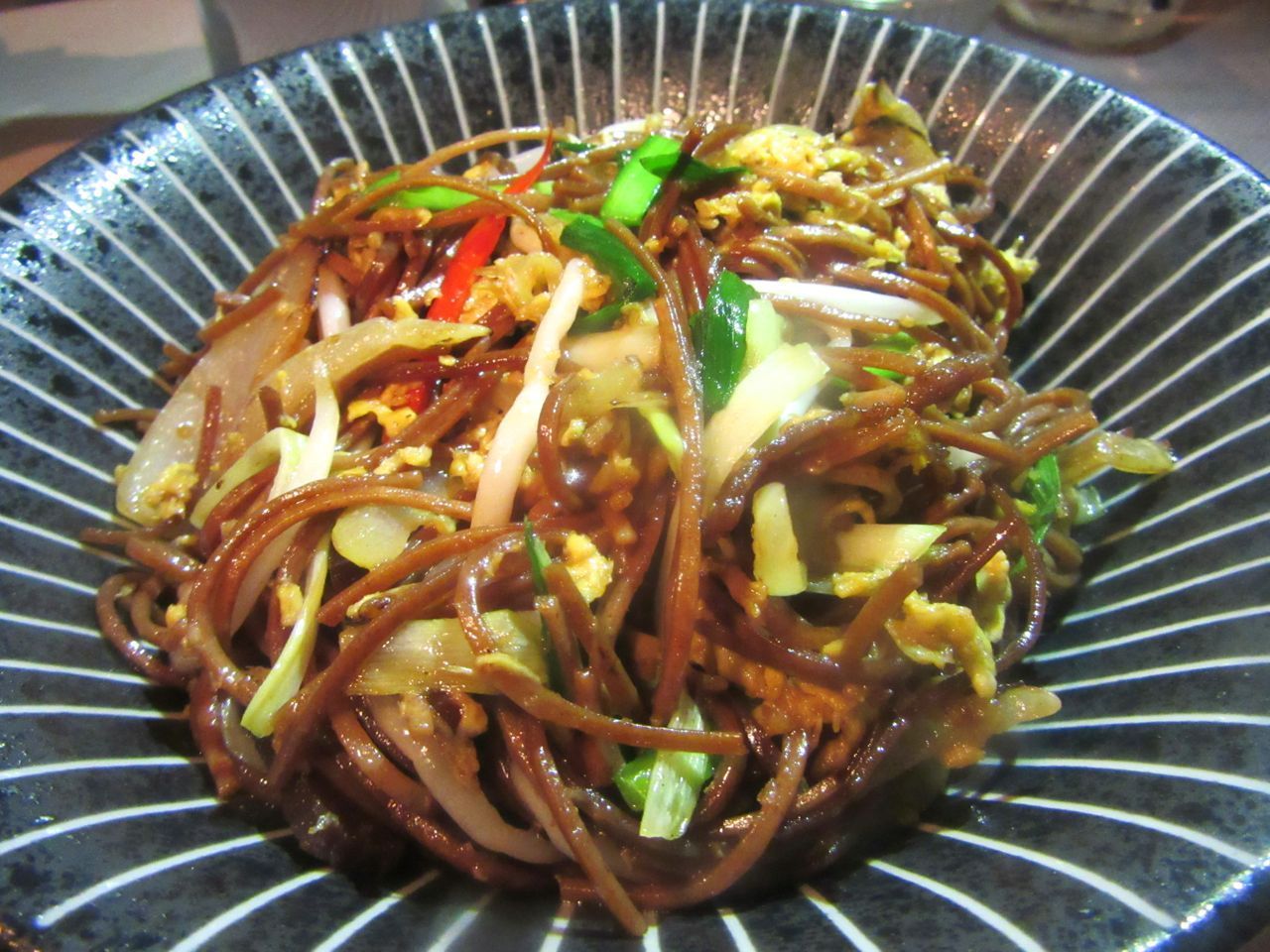
Barbequed pork and shrimp enliven buckwheat noodles, a dish from Anhui.
We’d ordered too much, of course – ceremonial waits for food give you time to digest and doze off, but when the buckwheat noodles tossed with barbequed pork and shrimp finally did cross the finish line, they were so good, we revived and ate them too.

We can get tuna tartare anyway, I decide, though La Chine’s creators tout it as a big deal.
What we ate was not very Chinese -- well, not upscale New York Chinese as I know it. I would call it near Chinese. It was not even as near Chinese as Red Farm’s unabashedly “Inauthentic Chinese.” Maybe this is how homegrown moguls eat now in Shanghai and Hong Kong. I haven’t been there since the Hong Kong turnover.
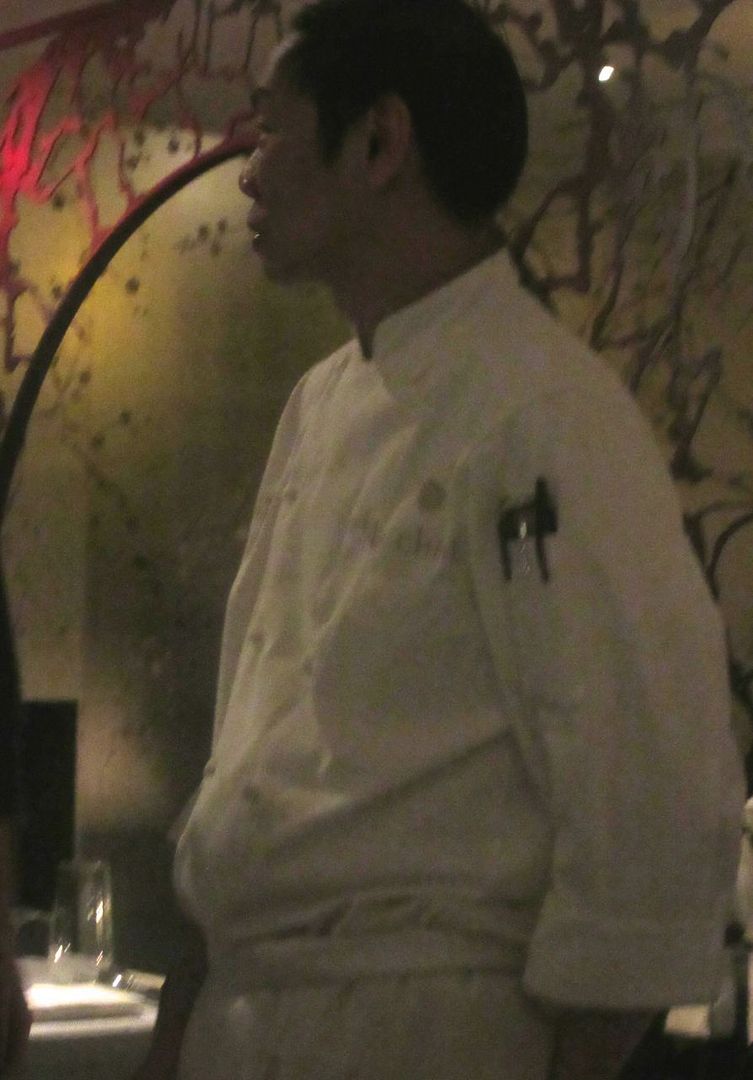
Chef Kong Khai Meng comes out to chat with a customer he knows. My camera can’t capture it.
I spoke to La Chine’s general manager, Markus Tschuschnig. Hilton runs all the Waldorfs, it seems. (Yes, I also thought there was only one.) That might explain why it doesn’t feel like a colonial Chinese outpost. Hilton had sent him, the culinary director David Garcelon and the Raw Bar manager, a Korean-born sushi chef, to China for research. There, the Chinese consultant, master chef Jereme Leung, escorted them to restaurants, mostly in Shanghai, and then in Wenzhou, a Chinese port “where people were eating raw fish before the Japanese did,” he told me. They hired executive chef Kong Khai Meng, a Leung protégé and veteran of high-end Asian kitchens, and sent him for a ten-day tour too.
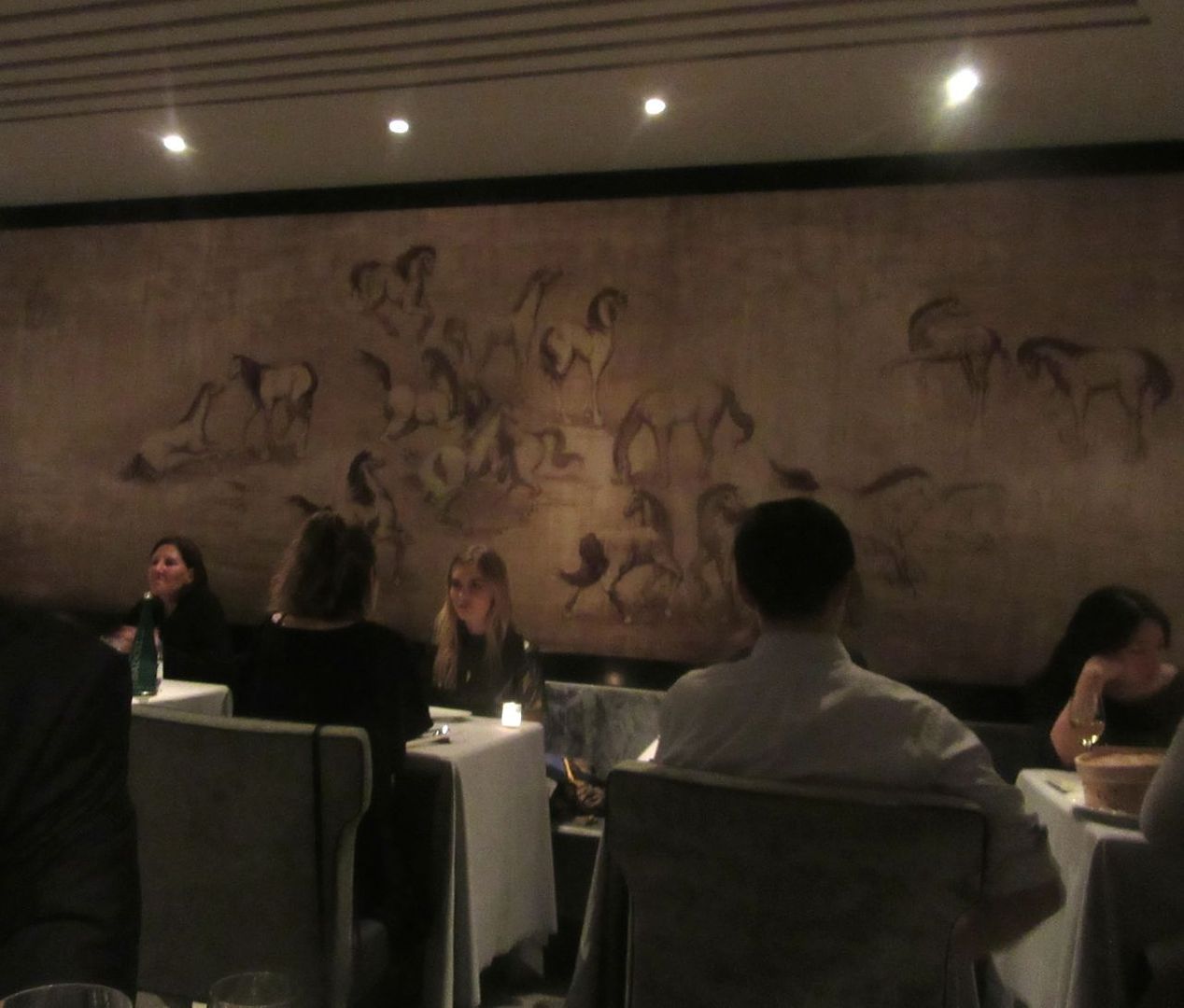
Horses cavort romantically on a nearby wall. Fish swim in the ladies room.
I am back two weeks later with three companions, still craving haute Chinese cooking. Clearly it’s better to be four, since smallish portions put a strain on friendship when we were six. La Chine has been discovered. Even at the unfashionable hour of 7:30, it’s already full. I spot many Asian faces. Locals? Hotel guests? The shocking pink orchids under the giant chandelier are paler pink tonight, and the calla lilies on the table are ominously black.
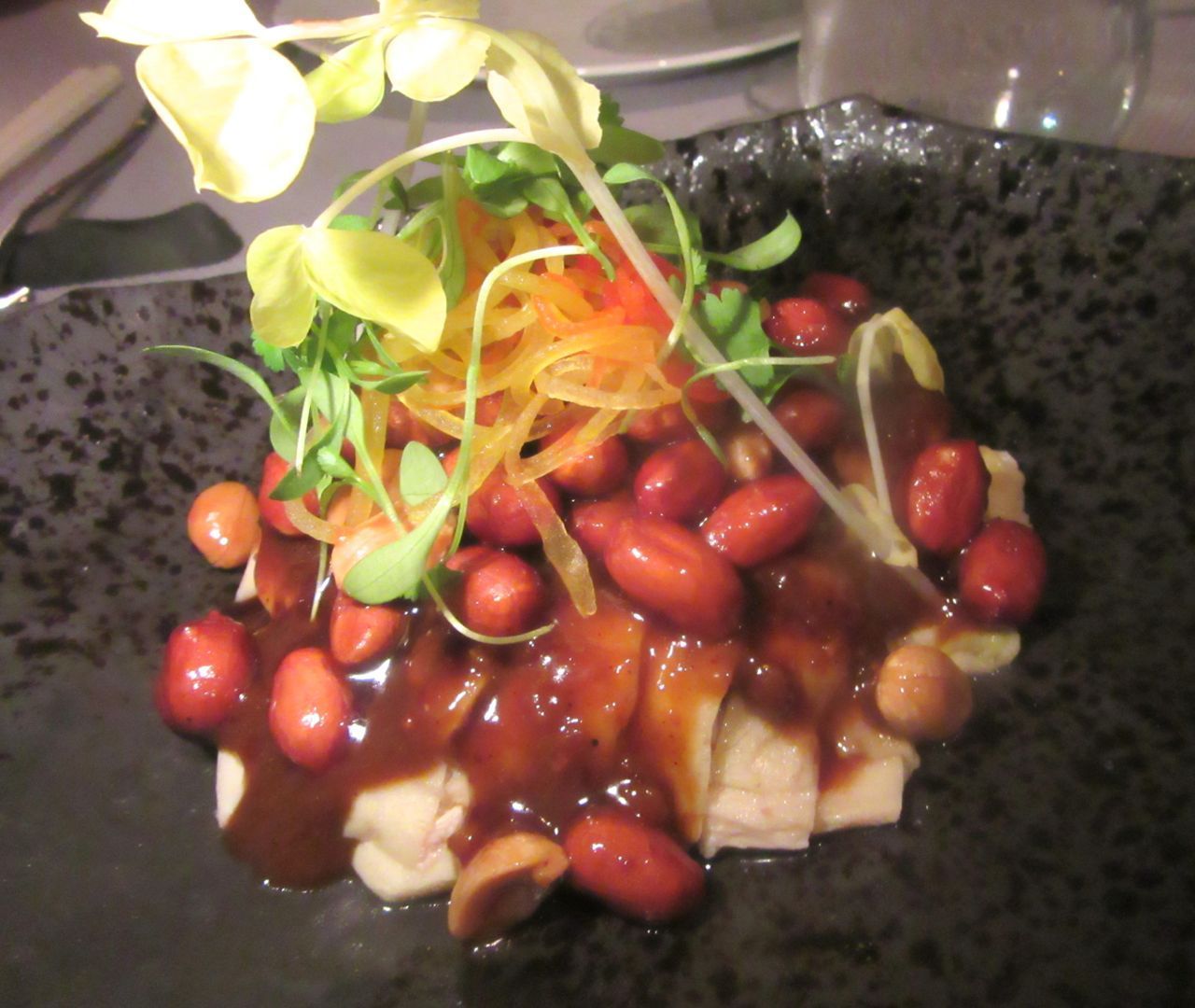
Don’t overlook spicy poached chicken with peanuts. It’s not as boring as it might sound.
An old friend, the sake ninja Chris Johnson, has been hired to massage the sake lovers. He guides my generous friend Wilfred to a bottle of $98 Hanagaki. I order the “Silk Road,” bonded bourbon with a mint flourish. The straw is painted to look like a birch twig and is unpleasant in my mouth, but more unpleasant is being charged $18 for a $16 drink. (I didn’t notice till the next day when I glance at the check.)
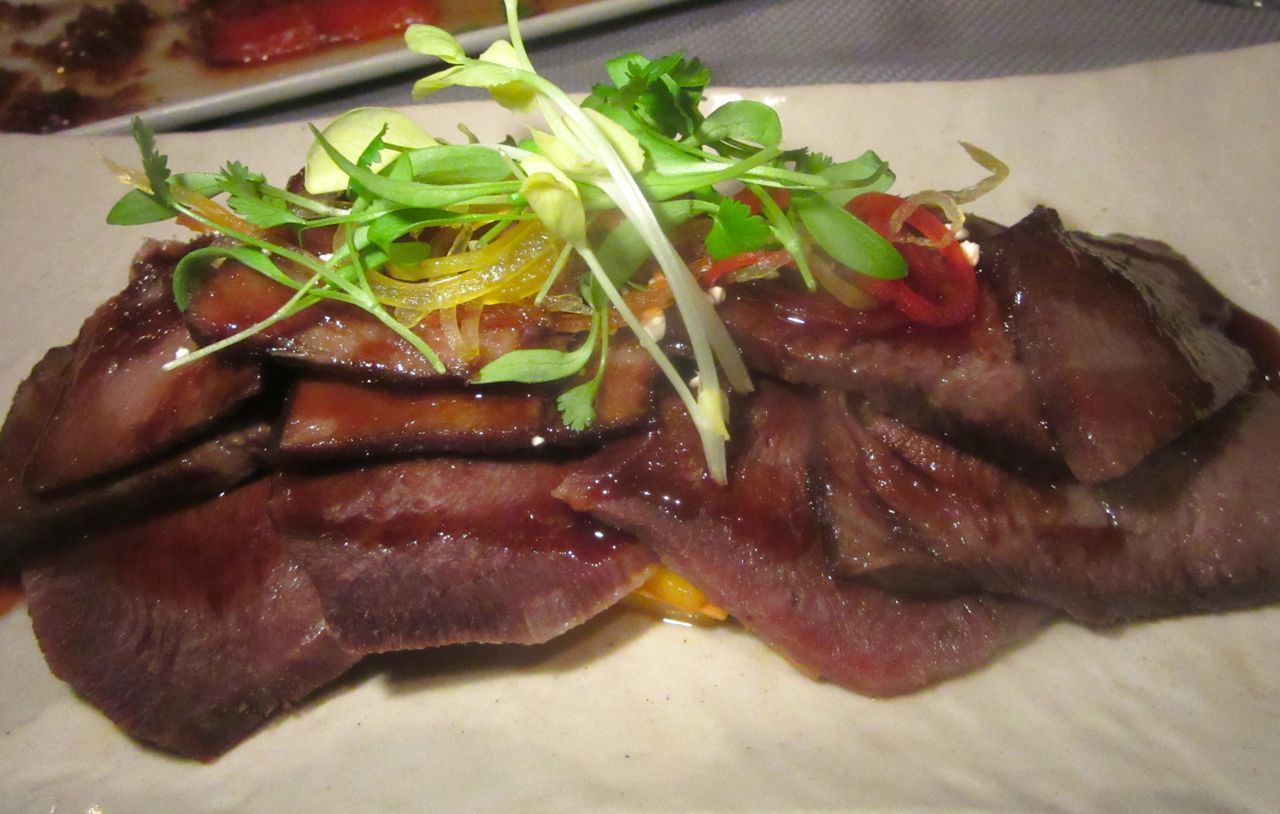
Beef tongue slices scented with lemongrass are layered on mango.
It probably isn’t deliberate larceny, I decide. Even with a beefed-up staff, the house still feels in previews, captains confused if not overwhelmed. The kitchen timing is off too, with long pauses between dishes, betraying the 1973 quote from James Beard that prefaces the menu:
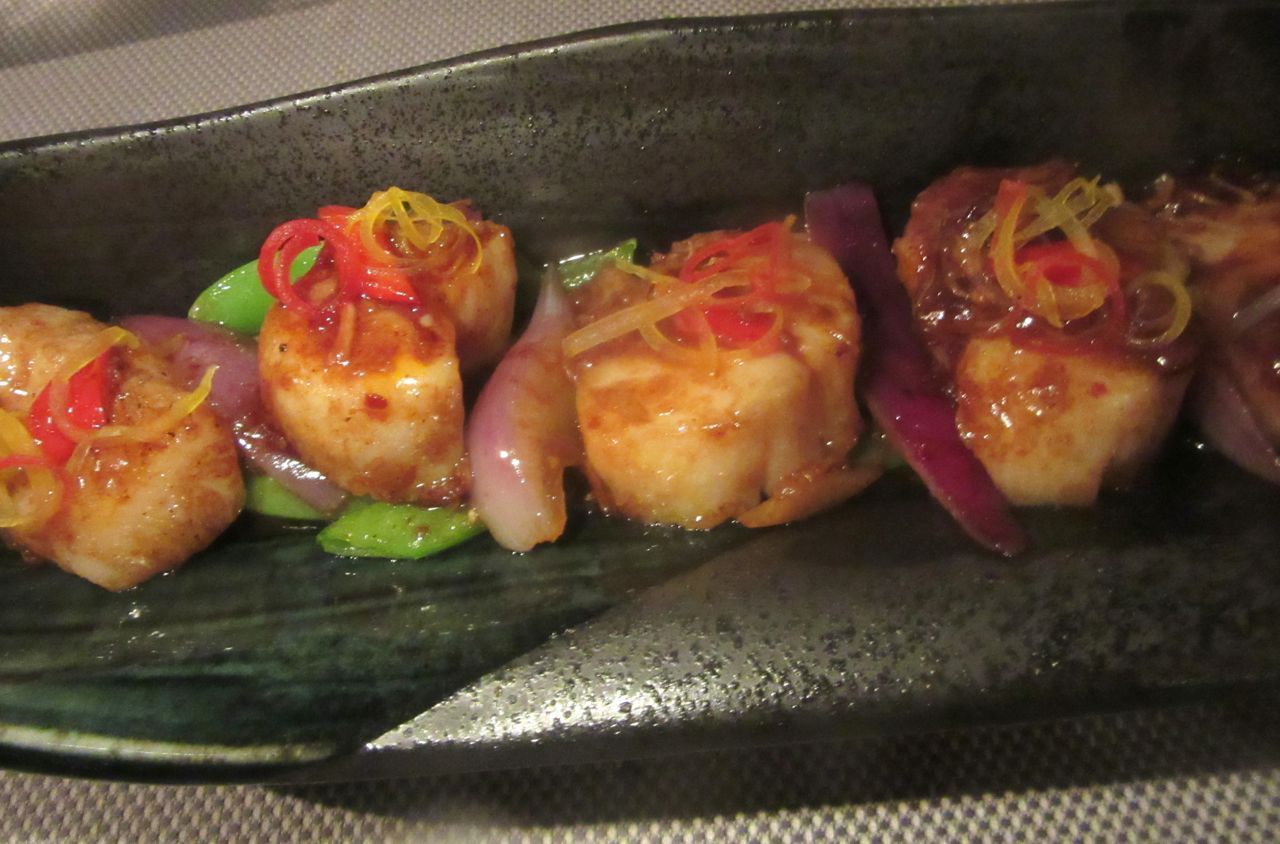
These smallish diver scallops with honshimeli mushrooms in XO sauce at $38 are forgettable.
“In all the world there are only really two great cuisines: the Chinese and the French. Chinese was created first…it uses ingredients no other employs, and it is distinctive in that, for the most part, it is cuisine a la minute.”

At a second tasting, I decided to give cured Tasmanian salmon with picked radish a try.
While Wilfred and his friends are being sociable, and brooding over cocktails vs. sake, I take over the ordering, favoring dishes I’ve not had before. I surrender to the “Chinese Raw Bar.” An Asian server pours Chinese fermented fish and soy sauce over cured Tasmanian trout, dotted with bits of pickled radish. The fish drowns in the not-very-flattering puddle.
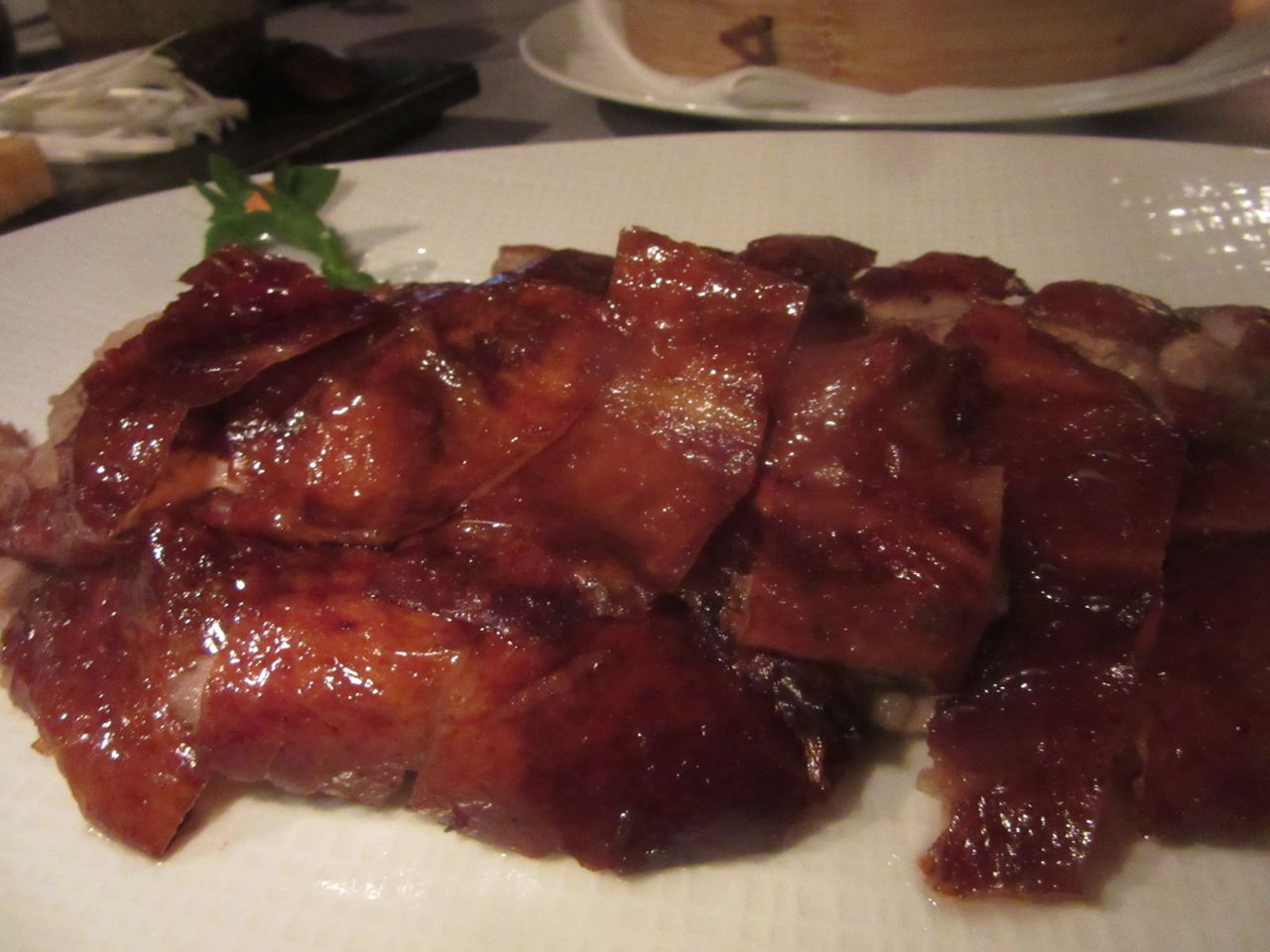
We’re only four, but we order a whole Peking duck. I’m very impressed by delicate crepes.
We’re a compatible group. Everyone agrees to try beef tongue slices on mango with lemongrass and basil. Impressive, no? How often are you in a quorum favoring beef tongue? It turns out to be a dish I’d not repeat. The big surprise of the appetizer round is the chilled, spicy poached chicken. Normally I would have no special hope for poached chicken, but I figure my friends deserve something recognizable, rather than the sea whelk with tangy bean paste that I don’t order.
I’m not sure what chef Kong did to the gossamer white meat or the nuts, those superlative peanuts. (It’s the sauce, I’m told -- special peppercorns with scallion, ginger and garlic in the cooking oil, flavoring the poached chicken. And the unusually commanding peanuts, wok-roasted a la minute after shelling.

The whole duck comes with a follow-up: minced duck with pine nuts in crisp lettuce cups.
That $16 small plate is undeniably the best choice of the night, better even than large, slightly chewy pieces of Maine lobster, wok seared, with black bean and wild fern. Better than the remarkably good Peking duck. We order the whole duck because it comes with a follow-up dish of chopped duck with water chestnuts, garlic, scallion, and pine nuts in four crisp lettuce cups.
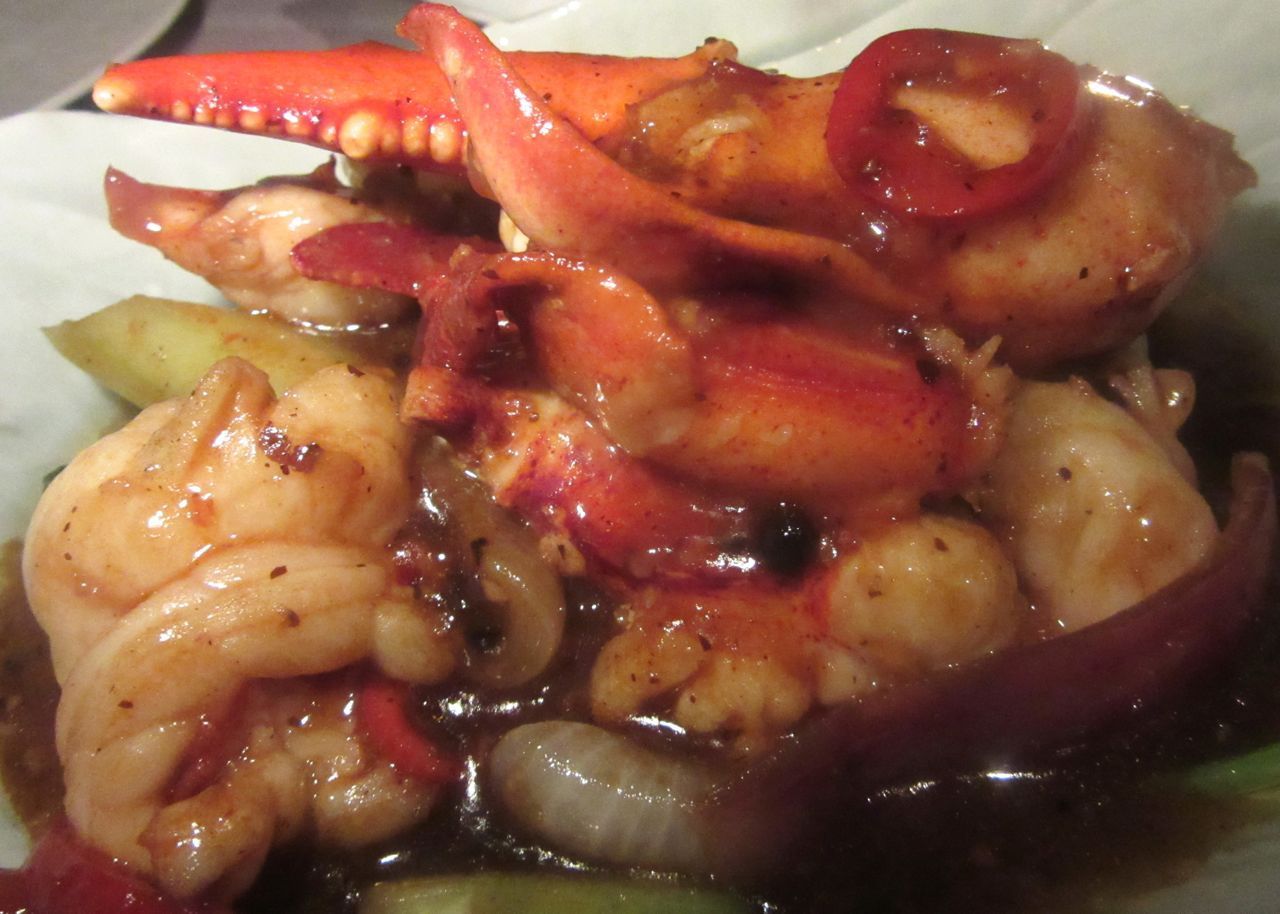
Large chunks of Maine lobster are stir-fried with black bean and wild fern as in Guangdong.
It is also better than the delicate and very good house-made carrot tofu with straw mushrooms, English peas, and oyster sauce in a stone casserole, which tofu lovers (like me) especially like. Still we pile the tofu on the house gift of crab-dotted jasmine rice with flying fish roe, good too, but ultimately impossible to finish. Our dedicated tasters are running out of steam.
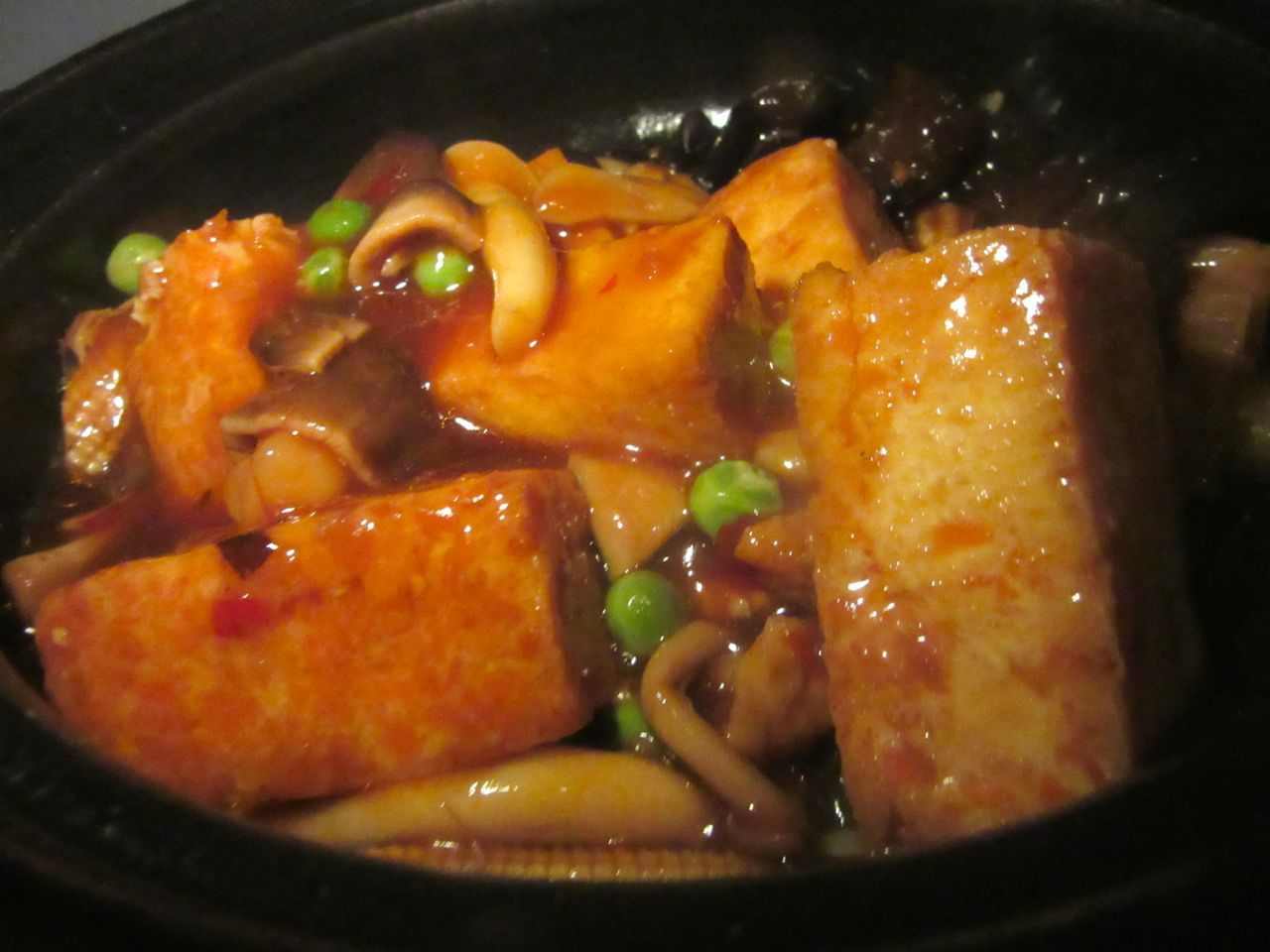
Craving a veggie, I choose house-made carrot tofu with English peas in oyster sauce.
“Let’s have one dessert anyway,” I urge. But Wilfred wants coconut tapioca soup with dragon fruit, mango, and horned melon, and Shana and I have already settled on dark chocolate and Szechuan pepper cake with molten sesame ganache and ginger ice cream. So that dictates two. I taste both. Horned melon for the first time. Good choices.
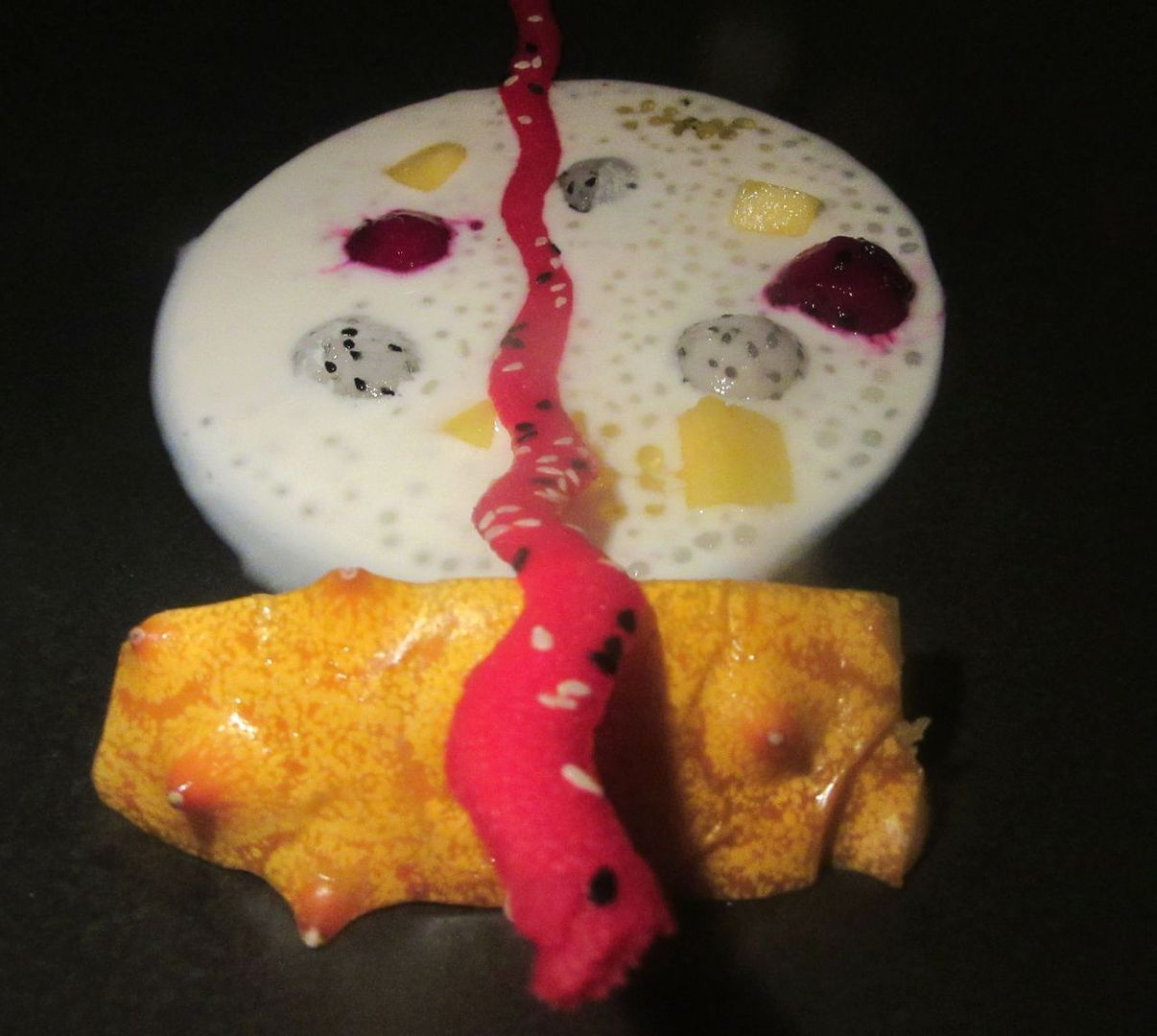
Sweet coconut tapioca soup comes with tropical fruits: mango, dragon fruit, and horned melon.
Curious about the tab? Six people trying not to over-splurge spent $385 with tip and tax. Four sake adventurers, seemingly indifferent to cost, spent $550. Should you dive in? I have never fully recovered from losing the miraculously satiny stir-fries of Uncle Tai’s Hunan Yuan when that master chef moved from Third Avenue and 62nd Street to Texas. (Click here to read “Star-Struck at Hunan Yuan.”) So, I will keep tasting, still full of hope for more ambitious Chinoserie in my town.

Molten sesame ganache and ginger ice cream escort dark chocolate and Szechuan pepper cake.
The Waldorf-Astoria, 540 Lexington Avenue between 49th and 50th streets. 212 872 4913. Dinner Tuesday through Saturday 5:30 pm to 10:30 pm. Closed Sunday and Monday.
***
Photos may not be used without permission of Gael Greene. Copyright 2015. All rights reserved.
Click here to return to BITE listings. Follow my twitterings by clicking here.
See my vintage treasures on my Etsy vintage handbag site by clicking here.
More BITES You Might Savor...
Save
Save